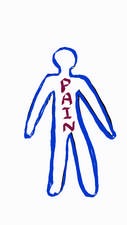Fibromyalgia and Essential Oils
Apr 21st 2021
Posted by Stephanie Chambers
by Stephanie Chambers
Fibromyalgia is a strange condition. It’s basically chronic, widespread pain accompanied by fatigue, disturbed sleep and an increased sensitivity to being touched. Some also experience tingling skin, muscle spasms, weak limbs, nerve pain, palpitations, muscle twitching, bowel problems and a host of other issues. Many also experience fogginess such as an inability to concentrate, memory problems and other cognitive issues. And anxiety and depression are commonly also experienced.
Why Is It Hard to Work Out That You Have It?

Diagnosing fibromyalgia can be challenging, in part because there is no single, standardized laboratory test to confirm its presence. For many years, physicians relied on the 1990 American College of Rheumatology (ACR) criteria, which focused on the presence of widespread pain and tenderness at 18 specific points on the body. Although these criteria were developed primarily for research, they were frequently used in clinical practice.
In 2010, the ACR updated the criteria to better reflect the full range of symptoms experienced by patients. The revised guidelines removed the tender point exam and introduced the Widespread Pain Index (WPI) and Symptom Severity Scale (SSS) to account for symptoms like fatigue, sleep disturbances, and cogn
itive difficulties. Further revisions in 2016 refined the criteria to improve diagnostic accuracy and to emphasize patient-reported symptoms over physical exams.
Fibromyalgia is a common chronic condition, affecting approximately 2% of the adult population, with a higher prevalence among women.1 Despite its prevalence, many patients report delays in diagnosis, often seeing multiple healthcare providers over several years before receiving confirmation. This can be due to the overlap of fibromyalgia symptoms with other disorders, the absence of definitive lab findings, or variability in physician familiarity with the condition.
It’s important to note that fibromyalgia is not a psychological disorder, though its symptoms may be misunderstood or minimized. Research suggests that the condition involves central sensitization or a heightened sensitivity in the way the brain and spinal cord process pain signals. In other words, the nervous system amplifies pain perception, even in response to non-painful stimuli, a phenomenon known as allodynia.
Unlike conditions such as arthritis, fibromyalgia does not cause inflammation or damage to joints or tissues. This can be confusing, as the pain is very real but does not correlate with structural changes visible on imaging or lab tests. The mismatch between the intensity of symptoms and the lack of physical findings can be frustrating for both patients and providers. However, the current medical consensus recognizes fibromyalgia as a legitimate, neurological condition that requires a comprehensive, empathetic approach to diagnosis and treatment.
What Causes The Lower Pain Threshold?
Unfortunately, although there have been quite a few research studies, the verdict is not yet clear. Sometimes it seems to be triggered by surgery or an accident, but othertimes, there is no trigger. There is speculation that it is due to "central sensitization" and that the lower pain threshold is due to pain-sensitive nerve cells in the spinal cord or brain becoming more reactive.
Some research 2 has shown that people with the condition don’t have normal blood flow patterns in their brains and other research3 has shown that neurotransmitter levels are also different than normal. Some research has shown that it may have an hereditary component. Others think it is stress-related4 because a lot of people suffering from it also have stress-related disorders such as PTSD, chronic fatigue, depression and irritable bowel syndrome.
Just like the cause, the cure is equally as unknown. In the US there are three drugs commonly prescribed. The first one, Duloxetine, was originally designed to treat depression. The second one, Milnacipran is an antidepressant and nerve pain medication. The third drug, Pregaballin, is an anti-convulsant, or anti-seizure drug, that was designed to treat pain caused by damage to the nerves and appears to reduce activity within the central nervous system. But how it reduces pain is unclear.
Of course, some doctors also prescribe painkillers for the condition, even though it is generally recognized that these aren’t very effective for fibromyalgia pain. Sometimes Nonsteroidal Anti-Inflammatory Drugs (NSAIDs) are prescribed even though inflammation is not a symptom of fibromyalgia.
Some doctors test for other conditions when a patient's fibromyalgia worsens for no specific reason. For example, they could also have lyme disease, hypothyroidism, low cortisol production, or tooth/gum infections. Others order blood tests for vitamin B1 and B6 levels, and “total” and “free” carnitine levels to check that this isn’t adding to their fatigue.
How Can You Cope With the Pain?
Pain thresholds vary between individuals. Some people naturally tolerate pain better than others, while those with conditions like fibromyalgia may experience heightened sensitivity even to mild stimuli. Morning joint stiffness is a symptom reported by some individuals with fibromyalgia. This can resemble symptoms of inflammatory conditions such as arthritis, although the underlying causes are different. Unlike arthritis, fibromyalgia is not associated with inflammation or deterioration in the joints or tissues. Instead, the pain is believed to result from abnormal processing of pain signals in the central nervous system.
Various coping strategies have been explored by people living with fibromyalgia. Meditation techniques may help reduce the perception of pain and improve relaxation, although they are not a comprehensive solution. Some individuals report symptom relief from complementary approaches such as subtle vibrational therapies, a Vata-reducing Ayurvedic diet, or vitamin D supplementation. While evidence supporting these methods is limited, early research suggests that vitamin D may play a role in managing fibromyalgia symptoms.5
Exercise Appears to Help
Some research that seems to have a practical application relates to exercise and fibromyalgia. A good summary of the research 6 in 2011 concluded that, “The benefits of exercise training for individuals with fibromyalgia are well documented in recent high-quality reviews and meta-analyses and include reduction of pain and depression and improvement in global health and physical function.” The types of exercise modalities that have been studied so far in relation to fibromyalgia include aerobic and strengthening exercises (both on land and in water), Tai Chi, Chi Gong and Yoga, Nordic Walking, vibration, and physical activity as part of a normal lifestyle.
Which Essential Oils Have Been Found to Help?
In terms of making this easier to proceed with a normal lifestyle, you may like to try the following Essential Oils which others have found beneficial for fibromyalgia:
- Clary Sage – diluted 3–5% in any Jojoba or Hazelnut oil and gently applied to affected areas or diluted with water and sprayed on
- Lavender – diluted 3–5% in a carrier oil and gently applied on sore muscles or diluted with water and sprayed on
- Sweet Marjoram – diluted 2% in a carrier oil and gently applied on tense muscles or diluted with a cup of salt (or similar) and put in a full bath
- Roman Chamomile – diluted 5-10% in Jojoba or Hazelnut oil and gently applied on painful areas.
Note: 2% dilution means 10 drops of Essential Oil to a tablespoon of base oil. 3-5% dilution means 15-25 drops of Essential Oil to a tablespoon of base oil. 5-10% dilution means 25-50 drops of Essential Oil to a tablespoon of base oil.
To deal with the other symptoms:
- Fatigue – see Essential Oils for energy and vitality.
- Depression – see Essential Oils for depression or try Stress Free Roll-On Relief
- Anxiety – see Essential Oils for anxiety or try our Anxiety Free Roll-On Relief
- Sleep disturbances – see Essential Oils for sleep disorders or try our Deep Rest Roll-On Relief
- Brain fog – try our Mental Energizer Roll-On Relief.
You may also like to see our page about Essential Oils and fibromyalgia for more details on this condition.
Sources:
1 http://www.ncbi.nlm.nih.gov/pubmed/18163497
2 http://www.ncbi.nlm.nih.gov/pubmed/?term=7612042 and
http://www.ncbi.nlm.nih.gov/pubmed/11145042
3 http://www.ncbi.nlm.nih.gov/pubmed/21878603
4 http://www.ncbi.nlm.nih.gov/pubmed/18270311
5 http://www.iasp-pain.org/PublicationsNews/NewsDetail.aspx?ItemNumber=2022
6 http://www.ncbi.nlm.nih.gov/pmc/articles/PMC3165132/
Disclaimer: The statements made in this blog have not been evaluated by the U.S. Food and Drug Administration (FDA). They are not intended to diagnose, cure or prevent any disease. If a condition persists, please contact your physician or healthcare provider. The information provided is not a substitute for a face-to-face consultation with a healthcare provider, and should not be construed as medical advice.
Original Published: 2015-04-24 / Last Modified: 2025-6-4

